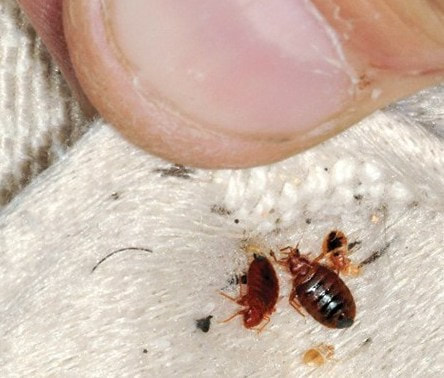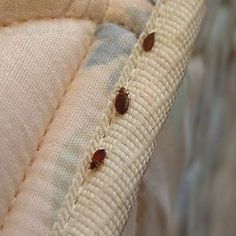Professional Bed Bug Exterminator: DC Services and Heat Treatment
Professional Bed Bug Exterminator: DC Services and Heat Treatment
Blog Article
Discovering the Scientific Research Behind Bed Bug Warm Treatments as a Lasting Bug Administration Approach
In the world of parasite administration, the mission for efficient and lasting options continues to be a consistent search. One such technique that has actually acquired traction in recent years is making use of warmth therapies to combat bed insect problems. By utilizing the science behind thermal fatality points for these persistent insects, warm treatments provide a promising alternative to typical chemical-based approaches. The complexities of just how heat effectively eliminates bed insects and the more comprehensive effects for lasting pest monitoring methods make this a subject worth discovering additionally.
Bed Pest Warm Treatment Refine

Thermal Fatality Point for Bed Pests
Exposing bed insects to raised temperature levels beyond their thermal tolerance array is vital for accomplishing effective obliteration in warm treatment processes. The thermal death factor for bed insects describes the temperature level at which these bugs can not endure. Research indicates that bed insects begin to perish when subjected to temperature levels over 113 ° F(45 ° C) for a continual period. As the temperature enhances, so does the death price of bed bugs. At around 118 ° F(48 ° C ), bed insects start to pass away swiftly, with a death rate of almost 99% within mins of exposure. This shows the level of sensitivity of bed insects to high temperatures and highlights the efficiency of warmth therapies in eradicating invasions. By reaching and maintaining temperatures over the thermal death factor for bed pests, parasite monitoring professionals can make certain comprehensive elimination of bed insect populaces, including hard-to-reach areas where chemical treatments might be much less efficient. Understanding the thermal death factor for bed pests is essential for implementing successful warm therapy techniques and attaining lasting pest administration end results.
Benefits of Warm Treatments
Having developed the crucial thermal fatality point for bed bugs, it is essential to now check out the substantial benefits that warmth treatments provide in effectively eliminating these durable parasites. Heat therapies existing several vital benefits when compared to traditional chemical techniques. One of the primary benefits is that heat can penetrate deep right into crevices and cracks where bed check this site out pests hide, ensuring that also the most hard-to-reach areas are heated up to dangerous temperature levels. This thorough approach not just kills live insects however also targets bed bug eggs, preventing future invasions.
In addition, warmth treatments are ecologically pleasant and non-toxic, making them a sustainable parasite monitoring technique. Unlike chemical pesticides, warm treatments do not leave damaging deposits that can pose dangers to human health and wellness or the atmosphere. This element is specifically important in delicate atmospheres such as healthcare facilities, schools, and suburbs where chemical usage might not be desirable.
Furthermore, warmth treatments have a high success price in eliminating bed insect infestations in a single therapy, decreasing the requirement for numerous check outs and lessening interruption to passengers. This performance not only saves time and cash but likewise gives satisfaction to those handling bed insect issues.
Performance of Warmth Therapy

Warmth treatments have the added advantage of eliminating bed pest eggs, which are frequently resistant to standard chemical therapies. On the whole, the effectiveness of heat treatments in removing bed pest infestations makes them a reputable and lasting parasite management strategy.
Sustainable Bug Monitoring Conveniences
Executing sustainable pest management techniques supplies lasting advantages for both the atmosphere and public health and wellness. By using techniques such as heat treatments for pest control, we can lower the dependence on damaging chemical pesticides that can have unfavorable impacts on communities and human health - exterminator. Lasting bug management strategies aid in protecting biodiversity find more info by targeting specific insects without harming non-target microorganisms, therefore preserving a balanced ecological community
Moreover, sustainable parasite administration techniques contribute to the overall health and wellness and well-being of the general public. By minimizing direct exposure to toxic chemicals made use of in conventional parasite control methods, warmth treatments give a much safer choice for insect monitoring in domestic, business, and public spaces. This decrease in chemical use likewise aids in avoiding chemical deposits from polluting dirt, air, and water, securing ecological quality.
Final Thought
Finally, bed insect warm therapies have been shown to be a sustainable and effective bug monitoring strategy. The thermal death factor for bed pests makes them susceptible to heat treatments, which have many benefits over traditional chemical treatments. The efficiency of warm therapies in removing bed pest infestations while reducing environmental effect highlights the possibility of this method as a sustainable service for bug control.
The bed pest warmth therapy procedure involves increasing the temperature within plagued areas to a level that successfully gets rid of bed insects and their eggs. By getting to and preserving temperature levels over the thermal fatality factor for bed pests, pest management professionals can make sure thorough removal of bed pest populaces, consisting of hard-to-reach locations where chemical view publisher site therapies might be much less reliable. One of the key benefits is that heat can penetrate deep right into crevices and cracks where bed pests conceal, ensuring that even the most hard-to-reach areas are heated to lethal temperatures. Unlike chemical treatments that may leave behind resistant populations, warm therapies use a environmentally friendly and non-toxic service that can penetrate deep right into furnishings, walls, and other hard-to-reach areas where bed pests conceal.
The thermal death point for bed pests makes them prone to warm therapies, which have various advantages over traditional chemical therapies.
Report this page